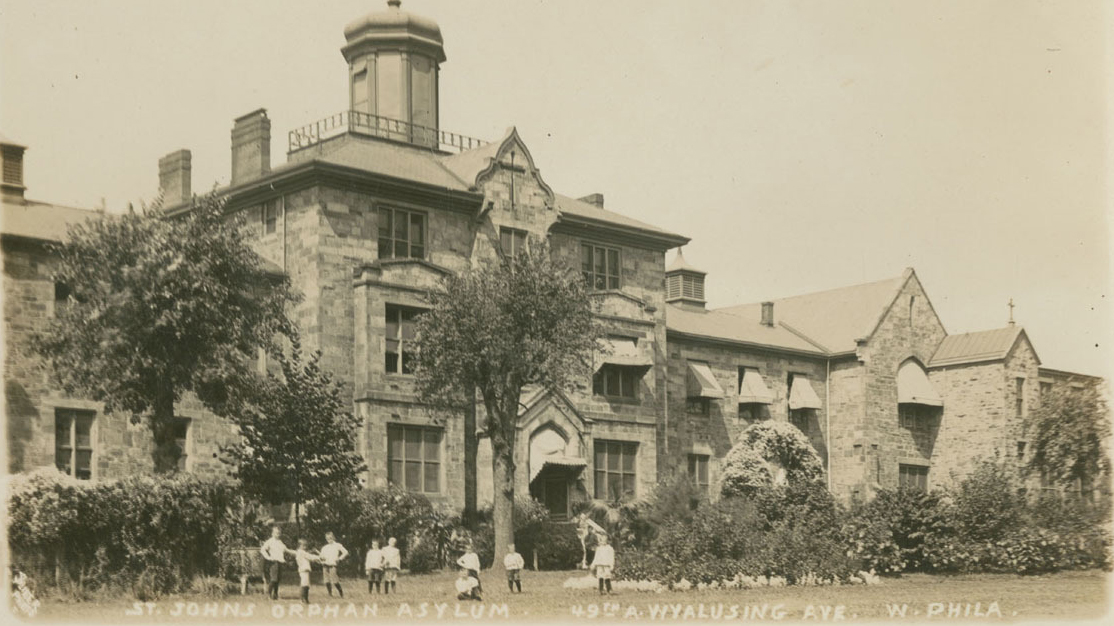If you listened to Episode 20, you may be wondering what happened to the children that were separated from their families.
There were a few options. But the main goal was to get these kids away from the streets and the dense urban neighborhoods they called home. Various organizations offered places for children that were orphans, half-orphans, or otherwise deemed needy or neglected. The best record of these different organizations is the 1904 Census of Benevolent Institutions. It lists 33 active institutions for housing children in Philadelphia during the Gilded Age, as well as another 16 day nurseries offering childcare for working mothers.
A map of these institutions shows that day nurseries, and some older homes for children, were located in the densely populated areas of the city. However, the majority of institutions that housed children, about two-thirds, were located in the greener areas of 1904 Philadelphia.
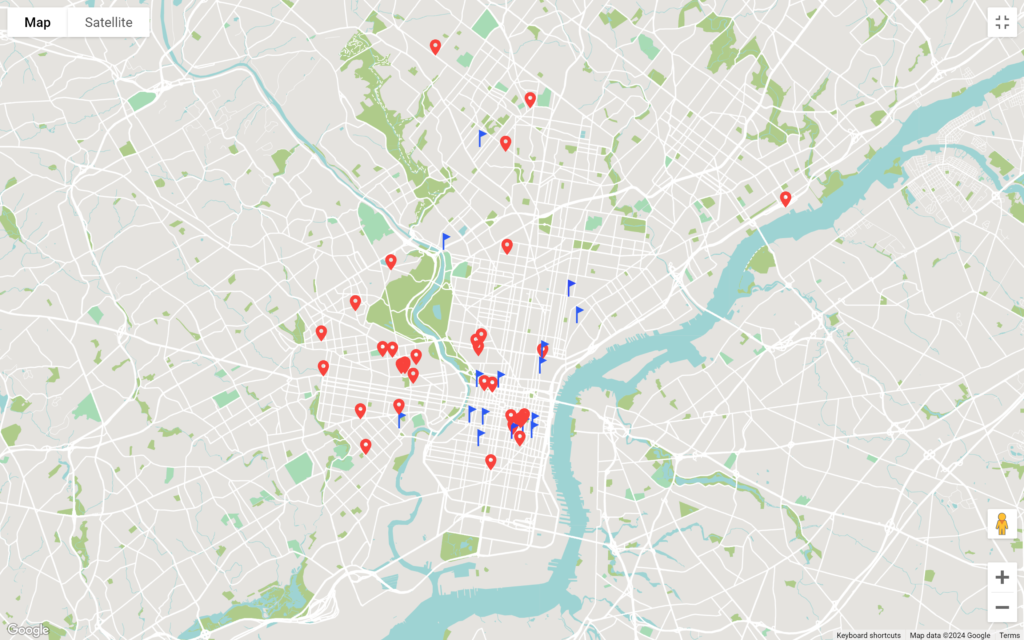
The list notes which children were welcomed at each institution. Some institutions were only open to girls or boys, some were only open to white children, while others offered places to Black, Jewish, Italian, or German children. There were a few institutions that were only open to children of veterans or Pennsylvania Railroad workers.
The 1904 census notes how many children were housed on January 1, 1904, how many were admitted during the year, and how many children were housed on December 31, 1904. Some institutions maintained a steady population, admitting just a few children each year. While others appeared to have high turnover. For example, the Catholic Home for Destitute Children at 1720 Race Street had 249 children on January 1, admitted and additional 207 children that year, and ended with a population of 257.
A few Gilded Age orphanages are still standing:
- St. John’s Orphan Asylum 4900 Wyalusing (still standing, now Genoa Healthcare)
- William Elkins Masonic Orphanage for Girls, North Broad and Hunting Park (still standing, now Prince Hall buildings)
- Girls Orphanage buildings, 34th and Walnut (still standing, now Music and Morgan/Weitzman Art buildings)
- Girard College, 2101 S. College Avenue (still standing, operating as a boarding school)
- Institution for the Blind, Overbrook (still standing)
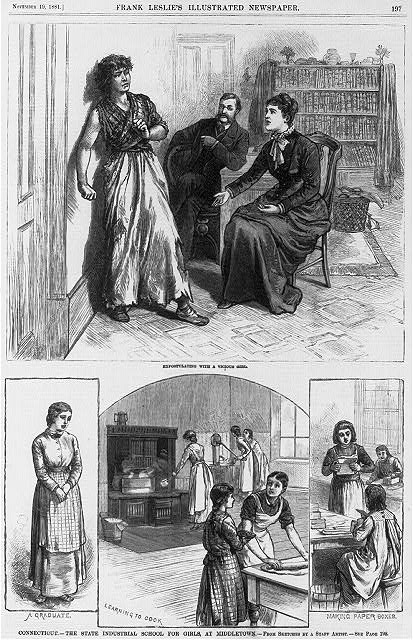
A “vicious girl” is turned into a model worker after attending a State Industiral School where she learns to cook and make paper boxes (1881, Library of Congress)
A working mother says goodbye to her child at a day nursery (1891, Library of Congress)
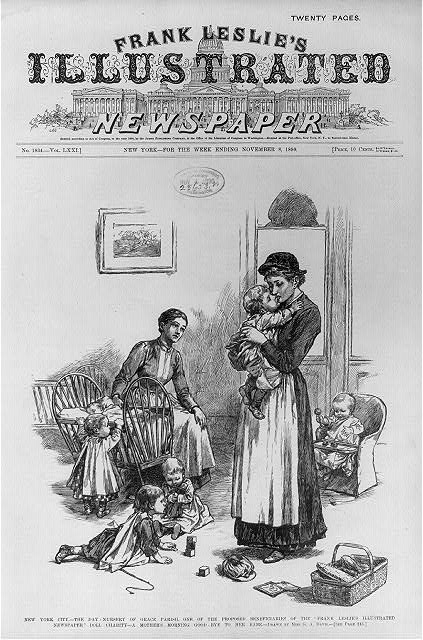
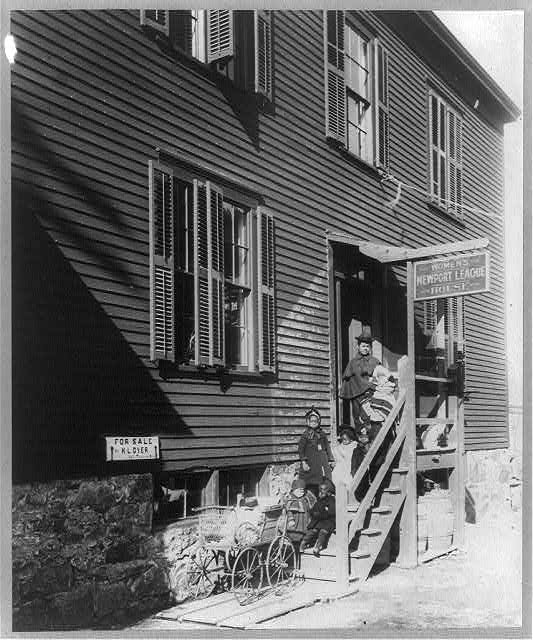
Day nursery in Newport, R.I., for Black working mothers (1890s, Library of Congress)
Knights of Labor cartoon shows a worker trying to climb a greased pole in order to reach higher wages. He’s carrying a child on his back, while his wife, with two more children in tow, grabs onto his shirt tails. Wealthy men in top hats ride by in a carriage. (Published in Puck, 1882, Library of Congress)
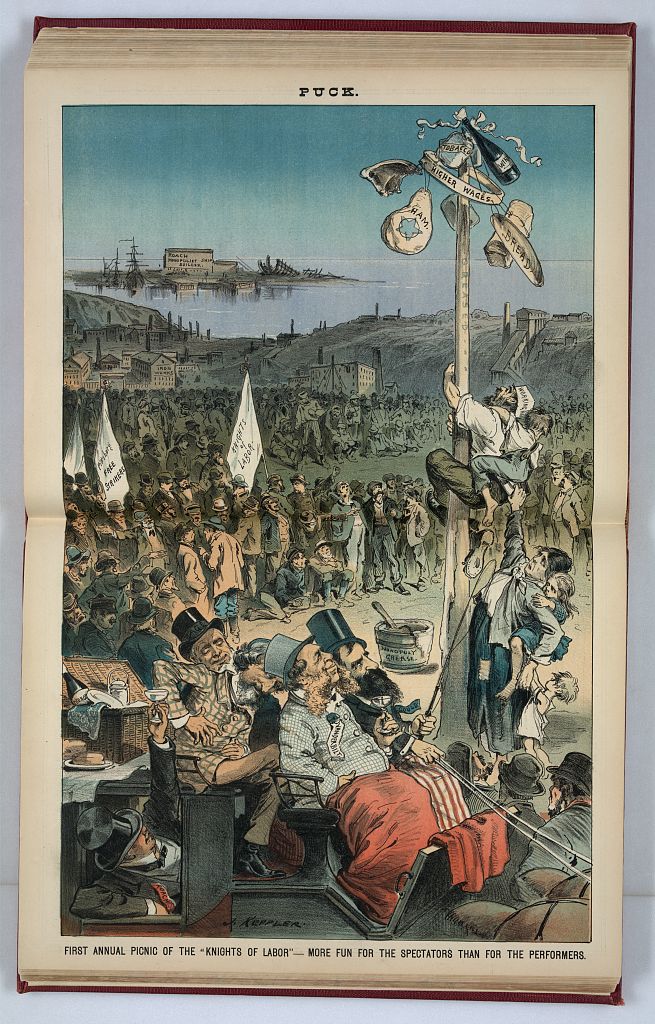

Women delegates attending Knights of Labor annual meeting 1886 (Library of Congress)
Resources
Anon. “Still Determined.” Philadelphia Inquirer. November 26, 1884: 8.
Anon. “The Strike Ended.” The Philadelphia Times. April 18, 1885:1.
Broder, Sherri. Tramps, Unfit Mothers, and Neglected Children: Negotiating the Family in Late-Nineteenth-Century Philadelphia. Philadelphia: University of Pennsylvania Press, 2002.
Clement, Priscilla Ferguson. “Nineteenth-Century Welfare Policy, Programs, and Poor Women: Philadelphia as a Case Study.” Feminist Studies, vol. 18, no. 1, 1992, pp. 35–58.
Cole, Peter. “African Americans and the Knights of Labor”, Blackpast website, January 24, 2022. https://www.blackpast.org/african-american-history/african-americans-and-the-knights-of-labor-1869-1949/
Currarino, Rosanne. The Labor Question in America : Economic Democracy in the Gilded Age. University of Illinois Press, 2011.
DePastino, Todd. Citizen Hobo : How a Century of Homelessness Shaped America. University of Chicago Press, 2003.
Dinwiddie, Emily Wayland. Housing Conditions in Philadelphia. United States, n.p, 1904.
Du Bois, W. E. B. The Philadelphia Negro: A Social Study. Philadelphia: University of Pennsylvania Press, 1899.
Eaton, Isabel. “Special Report of Negro Domestic Service in the Seventh Ward Philadelphia.” The Philadelphia Negro. University of Pennsylvania Press, 1899.
Foner, Philip S., and Ronald L. Lewis, editors. The Black Worker, Volume 3: The Black Worker During the Era of the Knights of Labor. Temple University Press, 1978
Glassberg, David. “The Design of Reform: The Public Bath Movement in America.” American Studies, vol. 20, no. 2, 1979: 5–21.
Growing Up Philly, City of Philadelphia Department of Public Health, 2020. https://www.phila.gov/media/20200310161732/GrowingUpPhilly-031020.pdf
Hepp, John H. The Middle-Class City: Transforming Space and Time in Philadelphia 1876-1926. Philadelphia: University of Pennsylvania Press, 2003.
Hollis, Patricia. Women in Public, 1850-1900 : Documents of the Victorian Women’s Movement. Taylor & Francis Group, 2012.
Hunter, Tera W., et al. “HISTORICAL NOTE.” The Philadelphia Negro: A Social Study. University of Pennsylvania Press, 1996: 425–26.
Levine, Susan “‘Honor Each Noble Maid’: Women Workers and the Yonkers Carpet Weavers’ Strike of 1885.” New York History, vol. 62, no. 2, 1981: 153–76.
Levine, Susan. “Labor’s True Woman: Domesticity and Equal Rights in the Knights of Labor.” The Journal of American History, vol. 70, no. 2, 1983: 323-339.
Kahan, Michael. Pedestrian Matters: The Contested Meanings and Uses of Philadelphia’s Streets, 1850s-1920s. Dissertation. University of Pennsylvania. 2002.
Katz, Michael B. “Social Class in North American Urban History.” The Journal of Interdisciplinary History, vol. 11, no. 4, 1981: 579–605.
Phillips-Cunningham, Danielle T. Putting Their Hands on Race: Irish Immigrant and Southern Black Domestic Workers. Rutgers University Press, 2020.
San Gupta, Gunja. “Black and ‘Dangerous’?: African American Working Poor Perspectives on Juvenile Reform and Welfare in Victorian New York, 1840-1890.” The Journal of Negro History, vol. 86, no. 2, 2001: 99–131.
Schweik, Susan M. The Ugly Laws : Disability in Public, New York University Press, 2009.
Spain, Daphne. “Voluntary Associations with an Urban Presence.” How Women Saved the City, NED-New edition, University of Minnesota Press, 2001: 87–122.
Vapnek, Lara. Breadwinners: Working Women & Economic Independence 1865-1920. Chicago: University of Illinois Press, 2009.
Wang, Joan S. “Race, Gender, and Laundry Work: The Roles of Chinese Laundrymen and American Women in the United States, 1850-1950.” Journal of American Ethnic History. Vol. 24, no. 1, 2004: 58–99.
Wolfinger, James. Running the Rails : Capital and Labor in the Philadelphia Transit Industry, Cornell University Press, 2016.
